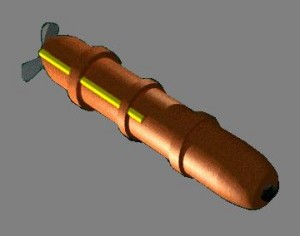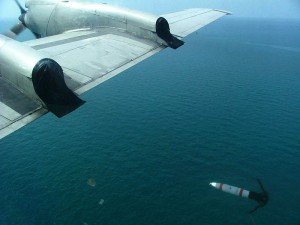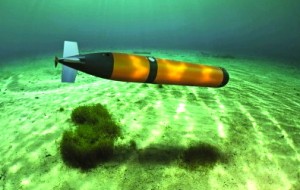2015-06-20 By Scott C. Truver
When naval mine warfare is discussed, the focus usually is on the technologies, systems, platforms and people needed to counter our adversaries’ use of naval mines.[1]
Indeed, when Commander Peter Bergen Henegouwen, HNLN, Commander, Standing NATO Mine Countermeasures Group 1, outlined for Second Line of Defense the “challenges of mine warfare,” he really meant “mine countermeasures”––MCM––i.e., mine-hunting and -sweeping.
Although mine-hunting/sweeping and offensive/defensive mine-laying are two sides of the same naval warfare “coin,” they are indeed very different functions, with very different prospects for success.
The seemingly enduring offense/defense imbalance in this warfare area, an imbalance that so heavily favors the mine, should stimulate U.S. Navy investment in the “winning” side: offensive mining as a means to carry out anti-access/area-denial (A2/AD) operations against our adversaries.
While there are indications that Navy “weapons that wait” are receiving greater attention among the operating forces and Navy leaders, particularly as a result of the “Pacific pivot” and the need to address potential adversaries’ capabilities, since the mid-1980s Navy mines and mining have represented an even more dismal story than MCM in the U.S. Navy––at best a “backwater” naval warfare area.[2]
During the Cold War, the Navy maintained a large stock of mines for both offense and defense.
Several types of bottom and moored antisubmarine mines (MK52/55/56/57) deployed by submarines and aircraft entered service in the 1950s and 1960s, and in 1980 these were joined by the MK60 deepwater encapsulated torpedo CAPTOR ASW moored mines armed with a MK37 lightweight torpedo.
The MK67 submarine-launched shallow-water mobile mine (SLMM), a modified MK37 torpedo, entered service in 1983.

Mine inventories also included general-purpose bombs fitted with multiple-influence mine target detection devices (TDDs), the shallow-water Destructors, which saw widespread employment at sea and on land during the Vietnam War.
But with the end of the Cold War, the U.S. Navy’s mine capabilities began to atrophy.
In mid-2015, no conventional mines remain, CAPTORs have been retired, and at one point the Navy had programmed the remaining obsolescent MK67 SLMMs to be phased out in 2012. Had that been carried out, U.S. attack submarines would have had no mining capability at all; only direct intercession by the CNO, Admiral Greenert, saved a handful of SLMMs.
The only other mines in service are the Quickstrike series of aircraft-deployed weapons (essentially upgrades of the 1960s Destructor mines): the dedicated, thin-wall MK65 2,300-pound bottom mine (in service since 1983); and the MK62 500-pound and MK63 1,000-pound bottom mines (1980). Like the Destructor series, these last two are general-purpose, shallow-water bomb-conversion weapons, using screw-in multiple-influence (magnetic and seismic sensors) TDDs in place of the bombs’ conventional fuses.
There are no surface mine-laying capabilities in the U.S. Navy.
While packages for mission sets beyond the baseline of MCM, surface warfare, and antisubmarine warfare (ASW) have been suggested for the littoral combat ship (LCS), there is no apparent interest in configuring LCS variants as minelayers.
Likewise, in mid-2015 there is little indication that the results of the 2014 Small Surface Combatant Task Force will include mine-laying for a next-generation, “frigate-like,” small warship.
That said, any ship could be a minelayer, often more than once. During the late summer 1984, Libya used the commercial ferry Ghat to deploy at least 19 weapons––Soviet/East German “export” mines of a type never seen before in the West––in the Red Sea and Gulf of Suez. Reports indicate that the North Korean navy would deploy some of its 50,000 mines from thousands of fishing boats and junks.
With the eventual demise of the MK67 SLMM, the nation’s sole mine-laying capabilities will reside in naval aviation and the U.S. Air Force.
The Navy’s P-3C Orion maritime patrol aircraft and F/A-18 Hornet/Super Hornet can drop Quick strike mines, but the P-3Cs are leaving service. They are being replaced by the P-8 Poseidon Multi-Mission Maritime Aircraft, which will also have a mining capability, but its ability to do so in meaningful numbers is years away.
The Air Force B-52H Stratofortress, B-1B Lancer, and B-2A Spirit strategic bombers constitute the nation’s only high-volume mining capability.
B-1s can carry more Quickstrike mines than the seemingly ageless B-52s (expected to remain active through 2040, the first B-52H having entered service in 1961), and B-52s and B-1s (but not B-2s) regularly train for and practice this mission.
For example, the multi-national Baltic Operations 2015 (BALTOPS15) exercise included dummy mines deployed from B-52s along the southern coast of Sweden, a defensive minefield to halt an aggressor’s amphibious assault.[3]

The 77 active B-52Hs can each carry about 45 MK62 Quickstrike or 18 MK63 mines or ten MK65s. The 66 B-1s can carry 84 MK62, or 24 MK63 (although the MK63s are not yet certified), or eight MK65 mines. And the 20 B-2s could carry 80 Mark 62s each. However, the availability of bombers, airborne tankers, and defensive escorts for mining campaigns is uncertain. There will certainly be intense competition for these scarce resources in future crises and conflicts.
In short, in 2015 the United States lacks modern mines and the means to deliver them.
The Navy has no surface-deployed mines.
A handful of obsolescent SLMMs––with perhaps less than optimum reliability, accuracy, and standoff characteristics––constitute the Navy’s only clandestine mining capability. The air-launched Quickstrikes have less-than-optimal accuracy and are best deployed in less-than-contested environments.
Indeed, the 1991 Gulf War was the last time that the Navy deployed mines in combat.
On that occasion, four A-6 Intruder bombers planted a tactical minefield of Quickstrikes at the mouth of the Kwahr az-Zubayr River to deny Iraqi access to the northern Gulf; one aircraft was lost to ground fire. Although there was little evidence that the minefield was successful, the Navy used the Quickstrikes also against bridges and airport runways, to better effect.
Thus the nation’s only offensive mining capability is resident in a small number of SLMMs and our only defensive mines are the shallow-water Quickstrikes.
Of greater long-term concern, there are only a few uniformed and civilian mine specialists, and a dwindling mine technological/industrial base has already presented challenges.
For example, the U.S. Navy has been developing the next-generation, multiple-influence, programmable Mark 71 Quickstrike TDD since mid-1980s.
Building Mines for B52 Launch from SldInfo.com on Vimeo.
Three decades later, only since 2012 has the system been acquired, and work is already under way to develop “smarter” algorithms for a broader target set.
Also, the Navy’s mines/mining community has long wanted the ability to command and control deployed mines remotely but has not received the R&D funding to support it.
There were several, albeit half-hearted, efforts after the Cold War ended in 1991 to develop new mines for wide-coverage, intermediate- and deepwater mines.
A joint-Australia/U.S. program for an improved submarine-launched mobile mine, based on the Mk48 torpedo, was proposed, but the proposal died in 2002 largely due to a short age of Mk48 weapons and increasing cost.
There was also the “2010 Mine” to complement the Quickstrike mines in deeper water. That mine program was to provide the U.S. Fleet with modern air-dropped mines by 2010.
But that, too, was canceled, as was another offensive, networked mine concept—the Sea Predator 2020 Mine. Lack of funding and “protection” resulted in nothing being fielded, at all.
At the direction of Admiral Greenert, in 2012 the Navy conducted an “analysis of alternatives” (AoA) for near- and far-term mining capabilities that would address shortfalls and gaps.
This included assessments of foreign mines, as well as American weapons.
As of mid-2015, the AoA has yet to be released, and its potential impact on the mine warfare program of record is unclear.
Nevertheless, low-level research and development for “advanced undersea weapon systems” has continued at the Office of Naval Research and the Naval Surface Warfare Command, in Panama City, Florida.[4]
With today’s unmanned-precision-vehicle and underwater communication technologies, the mining vision has significantly been expanded to make it more tactically responsive to changing situations, to provide much greater reach and utility in all phases of operations, including A2/AD missions.
And there are near-term proposals, for example, a Quickstrike mine fitted with wings and a Joint Direct Attack Munition kit.

“On 23 September 2014, a B-52H bomber at high altitude north of Guam accomplished an aviation first,” Colonel Michael W. Pietrucha wrote, “the release of a winged precision aerial mine….
The inert, orange and white GBU-62B(v-1)/B Quickstrike-ER (extended range) separated cleanly from the B-52, rolled, and three seconds after release, the BSU-104 wings deployed, transforming a free-fall munition into a medium-range weapon. Under command from the attached Joint Direct Attack Munition (JDAM) tail kit, the weapon flew around 40 nautical miles (nm) and impacted the water.
Had the weapon been a live system dropped in shallow water, it would have settled to the bottom to lie in wait for a target.
This effort marked the first advance in aerial mine-delivery techniques since 1943 and demonstrated a capability that substantially changes the potential of aerial mining in a threat environment.[5]
The great irony and paradox for the Navy lie in the fact that mines do work and that mines/mining will almost certainly be needed in a future crisis or conflict, perhaps as elements of the U.S. Department of Defense third offset strategy.[6]
The post–World War II operational history underscores the value of naval mines.
Of the 20 U.S. Navy ships that have been severely damaged or sunk by adversary action since September 1945, 15 were mine victims.
When the Navy employed mines in Haiphong in 1972, they were effective operationally and politically.
More to the point of mines and mining in Navy strategies and operations is that in various fleet exercises during the past decade, senior flag officers have been increasingly concerned that they could not carry out operation plans because of a lack of modern mines and platforms.
Thus the question remains: How much longer must the U.S. Navy’s “weapons that wait” continue to wait?
Dr. Truver is director of Gryphon Technologies’ TeamBlue National Security Programs.
He is the co-author of the U.S. Naval Institute Press Weapons that Wait: Mine Warfare in the U.S. Navy (1991), and since 1991 has supported the U.S. Navy’s mine warfare planning and advocacy efforts.
[1] This commentary is based on the author’s “WANTED: U.S. Navy Mine Warfare Champion,” Naval War College Review, Spring 2015, http://go.usa.gov/3quAm.
[2] Scott D. Burleson, David E. Everheart, Ronald E. Swart, and Scott C. Truver, “The Advanced Undersea Weapon System: On the Cusp of a Naval Warfare Transformation,” Naval Engineers Journal (March 2012), pp. 59–60; Joshua J. Edwards and Dennis M. Gallagher, “Mine and Undersea Warfare for the Future,” U.S. Naval Institute Proceedings (August 2014), pp. 72–73.
[3] Magnus Nordenman, “Analysis: BALTOPS 2015 Highlights New Friction Between West, Russia,” USNI News, 11 June 2015, http://news.usni.org/2015/06/11/analysis-baltops-2015-highlights-new-friction-between-west-russia?utm_source=USNI+News&utm_campaign=b3de45cedd-USNI_NEWS_DAILY&utm_medium=email&utm_term=0_0dd4a1450b-b3de45cedd-230475369&mc_cid=b3de45cedd&mc_eid=d9c10b9b63
[4] Burleson, Everheart, Swart, and Truver, “Advanced Undersea Weapon System.”
[5] Col Michael W. Pietrucha, “Twenty-First Century Aerial Mining,” Air & Space Power Journal, March-April 2015, p. 129.
[6] “Weapons Technology: Who’s Afraid of America?” The Economist, 13 June 2015, p. 57, http://www.economist.com/news/international/21654066-military-playing-field-more-even-it-has-been-many-years-big.
Editor’s Note: No platform fights alone. This is clearly true of mine warfare which is an integral part of maritime operations and the capability to insert force from the sea.
And such capabilities are crucial in shaping an effective Baltic defense approach where and sea operations, notably to insert force from the sea is a crucial and even defining capability for NATO to defend the Baltics against potential Russian aggression.
How can NATO best shape a credible defense strategy which meets the realistic performance of the key stakeholders in defense and security in Northern Europe?
…..Naval forces are crucial as well, not only to deal with Russian naval forces, but to support the Baltic operation as well. Modern amphibious forces are among the most useful assets to provide engagement capabilities, ranging from resupply, to air operations, to insertion forces at key choke points.
By not being based on Baltic territory, these forces are part of the overall defensive defense approach, and not credibly part of a forward deployed dagger at the heart of Russia argument that the Russian leadership will try to use if significant NATO forces were to be forward deployed upon Baltic territory itself.
Shaping an effective defensive template, leveraging collaborative Baltic efforts, with enhanced integrated air and naval forces will only get better as Western naval and air transformation occurs in the period ahead.
The relaunching of Baltic-focused counter mine activities described by Murielle Delaporte in the latest issue of OPERATIONELS based on her time embedded with the mine warfare task force is a key element of this effort.
The USN-USAF training for laying mines in BALTOPS 2015 is another.
The videos included in this article highlight their effort.
In the video at the top of the article, U.S. Navy and Air Force personnel build inert Mark-62 Quick Strike Navy mines in support of a BALTOPS 15 mission.
The video includes interviews from Staff Sgt. Ryan Cassady (Munitions Systems technician; 5 MUNS) and Petty Officer 1st Class David Toyloy (mineman; Navy Munitions Command, Unit Charleston)
2nd Bomb Wing Public Affairs, 6/10/15.
In the next video, weapon loaders from 5 AMXS, Minot load inert Navy Mark-62 Quick Strike mines to a B-52 Stratofortress in support of an ALTOPS 15 mission.
Included is an interview from SrA Peter Discipio; Weapons Loader, 5 AMXS.
2nd Bomb Wing Public Affairs, 6/11/15.

